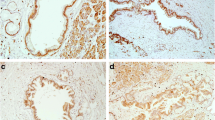Abstract
We examined the expressions of adhesion molecules (E-cadherin, β-catenin, CD44s, and CD44v6) and Ki-67 labeling index (Ki-67 LI) in low- and moderate-grade dysplasia and invasive carcinoma components in ten noninvasive intraductal papillary mucinous neoplasms (IPMNs) of the pancreas and eight invasive carcinomas associated with IPMNs of the pancreas using immunohistochemical methods. There was no significant difference in regard to the proportion of components expressing either E-cadherin or β-catenin in more than 70% of the tumor cells between the low- and moderate-grade dysplasia components. In contrast, the proportion of those in invasive carcinoma components was significantly lower than in low- or moderate-grade dysplasia components. Also, there was no significant difference in the proportion of components expressing CD44s or CD44v6 in more than 5% of tumor cells among low-grade dysplasia, moderate-grade dysplasia, and invasive carcinoma components. In contrast, the Ki-67 LI values increased in the order of low-grade dysplasia, moderate-grade dysplasia, and invasive carcinoma components, with significant differences among them. The present results indicate that carcinoma components are associated with a decrease in tumor cells expressing E-cadherin and β-catenin and have the highest proliferative activity.
Similar content being viewed by others
References
Longnecker DS, Hruban RH, Adler G, Küppel G (2000) Intraductal papillary-mucinous tumor of the pancreas. In: Hamilton SR, Aaltonen LA (eds) World Health Organization classifications of tumours. Pathology and genetics of tumours of the digestive system. IARC Press, Lyon, pp 237–240
Hruban RH, Pitman MB, Klimstra DS (2007) Intraductal neoplasms. In: Hahn KS IV (ed) AFIP atlas of tumor pathology. Tumor of the pancreas. AFIP, Washington, DC, pp 75–110
Solcia E, Capella C, Kloppel G (1997) Intraductal papillary-mucinous tumor. In: Rosai J (ed) Atlas of tumor pathology. Tumor of the pancreas. AFIP, Washington, DC, pp 53–64
Sohn TA, Yeo CJ, Cameron JL, Hruban RH, Fukushima N, Campbell KA, Lillemoe KD (2004) Intraductal papillary mucinous neoplasms of the pancreas: an updated experience. Ann Surg 239: 788–799
Takeichi M (1991) Cadherin cell adhesion receptors as a morphogenetic regulator. Science 251:1451–1455
Shiozaki H, Oka H, Inoue M, Tamura S, Monden M (1996) Ecadherin mediated adhesion system in cancer cells. Cancer (Phila) 77:1605–1613
Faleiro-Rodrigues C, Macedo-Pinto I, Pereira D, Ferreira VM, Lopes CS (2004) Association of E-cadherin and beta-catenin immunoexpression with clinicopathologic features in primary ovarian carcinomas. Hum Pathol 35:663–669
Watanabe I, Hasebe T, Sasaki S, Konishi M, Inoue K, Nakagohri T, Oda T, Mukai K, Kinoshita T (2003) Advanced pancreatic ductal cancer: fibrotic focus and beta-catenin expression correlate with outcome. Pancreas 26:326–333
Pignatelli M, Ansari TW, Gunter P, Liu D, Hirano S, Takeichi M, Kloppel G, Lemoine NR (1994) Loss of membranous E-cadherin expression in pancreatic cancer: correlation with lymph node metastasis, high grade, and advanced stage. J Pathol 174:243–248
Gunji N, Oda T, Todoroki T, Kanazawa N, Kawamoto T, Yuzawa K, Scarpa A, Fukao K (1998) Pancreatic carcinoma: correlation between E-cadherin and alpha-catenin expression status and liver metastasis. Cancer (Phila) 82:1649–1656
Aruffo A, Stamenkovic I, Melnick M, Underhill CB, Seed B (1990) CD44 is the principal cell surface receptor for hyaluronate. Cell 61:1303–1313
Lesley J, Hyman R, Kincade PW (1993) CD44 and its interaction with extracellular matrix. Adv Immunol 54:271–335
Marhaba R, Zoller M (2004) CD44 in cancer progression: adhesion, migration and growth regulation. J Mol Histol 35:211–231
Washington K, Gottfried MR, Telen MJ (1994) Expression of the cell adhesion molecule CD44 in gastric adenocarcinomas. Hum Pathol 25:1043–1049
Mulder JW, Wielenga VJ, Polak MM, van den Berg FM, Adolf GR, Herrlich P, Pals ST, Offerhaus GJ (1995) Expression of mutant p53 protein and CD44 variant proteins in colorectal tumorigenesis. Gut 36:76–80
Castella EM, Ariza A, Ojanguren I, Mate JL, Roca X, Fernandez-Vasalo A, Navas-Palacios JJ (1996) Differential expression of CD44v6 in adenocarcinoma of the pancreas: an immunohistochemical study. Virchows Arch 429:191–195
Gotoda T, Matsumura Y, Kondo H, Saitoh D, Shimada Y, Kosuge T, Kanai Y, Kakizoe T (1998) Expression of CD44 variants and its association with survival in pancreatic cancer. Jpn J Cancer Res 89:1033–1040
Chetty R, Serra S, Salahshor S, Alsaad K, Shih W, Blaszyk H, Woodgett JR, Tsao MS (2006) Expression of Wnt-signaling pathway proteins in intraductal papillary mucinous neoplasms of the pancreas: a tissue microarray analysis. Hum Pathol 37: 212–217
Nishikawa N, Kimura Y, Okita K, Zembutsu H, Furuhata T, Katsuramaki T, Kimura S, Asanuma H, Hirata K (2006) Intraductal papillary mucinous neoplasms of the pancreas: an analysis of protein expression and clinical features. J Hepatobiliary Pancreat Surg 13:327–335
Elzagheid A, Buhmeida A, Korkeila E, Collan Y, Syrjanen K, Pyrhonen S (2008) Nuclear beta-catenin expression as a prognostic factor in advanced colorectal carcinoma. World J Gastroenterol 14:3866–3871
Senda T, Iizuka-Kogo A, Onouchi T, Shimomura A (2007) Adenomatous polyposis coli (APC) plays multiple roles in the intestinal and colorectal epithelia. Med Mol Morphol 40:68–81
Terada T, Ohta T, Kitamura Y, Ashida K, Matsunaga Y (1998) Cell proliferative activity in intraductal papillary-mucinous neoplasms and invasive ductal adenocarcinomas of the pancreas: an immunohistochemical study. Arch Pathol Lab Med 122:42–46
Author information
Authors and Affiliations
Corresponding author
Rights and permissions
About this article
Cite this article
Okimura, A., Hirano, H., Nishigami, T. et al. Immunohistochemical analyses of E-cadherin, β-catenin, CD44s, and CD44v6 expressions, and Ki-67 labeling index in intraductal papillary mucinous neoplasms of the pancreas and associated invasive carcinomas. Med Mol Morphol 42, 222–229 (2009). https://doi.org/10.1007/s00795-009-0462-y
Received:
Accepted:
Published:
Issue Date:
DOI: https://doi.org/10.1007/s00795-009-0462-y




